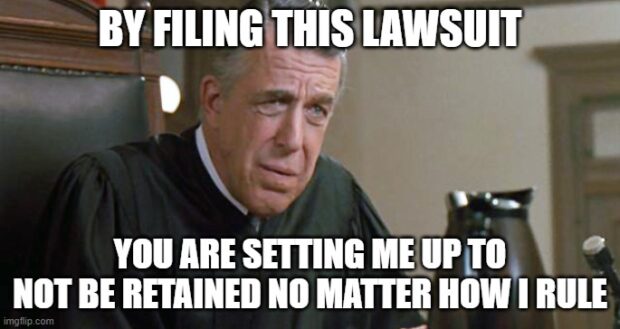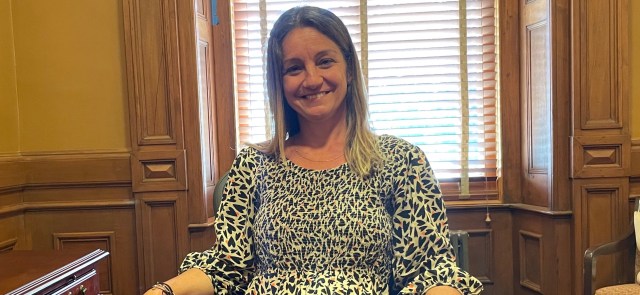Stay ahead of the curve as a political insider with deep policy analysis, daily briefings and policy-shaping tools.
Request a DemoVoucher program cost the state nearly $714 million this year
Our meme called it yesterday
Arizona for Abortion Access plans to file a lawsuit by Wednesday over the way their initiative is currently summarized in the description pamphlet that is sent to voters ahead of the election, Communications Director Dawn Penich told our reporter. The hearing for the pamphlet description for the Arizona Abortion Access Act met backlash from Democrat lawmakers on Monday. “We are profoundly disappointed that the Arizona Legislative Council today chose to disregard its statutory duty to produce an impartial summary of the Arizona Abortion Access Act by rejecting our common-sense request to use neutral, universally-recognized medical terminology in their ongoing effort to put extremist politics above Arizona voter’s rights,” Penich said in a prepared statement. The group is planning to sue in order to “ensure Arizona voters are presented with clear and accurate information before they cast their ballots,” Penich said. Gutierrez said during the hearing Tuesday that“scientific language is the most appropriate to use” and suggested an amendment to the initiative’s description which would have changed “unborn human being” to “fetus,” but it did not pass. Attorney Austin Yost, representing the Arizona for Abortion access campaign committee, said Monday the legislative staff did an “excellent job” preparing the summary but suggested the same amendment. “This amendment would make the summary neutral, objective and medically accurate, and it would be consistent throughout,” Yost said, pointing to a later line item in the description which used the term “fetus.” Yost said the council has a statutory duty to provide an impartial analysis and the term “unborn human being” is “tinged with partisan coloring.” Republican lawmakers disagreed, and said the use of both terms provided a balanced description of what the constitutional amendment would do. Stahl-Hamilton, said “fetus” is the most-medically accurate word to use, just as “spontaneous abortion” is the term for an accurate way to describe a miscarriage. However, Republicans said they were more focused on how the public understands terminology. “I’m not a doctor, Representative Stahl-Hamilton, I don’t care what the medical accurate term is,” Toma said. “The average person doesn’t refer to it that way. They refer to it as a miscarriage, and we commonly refer to it as that, because there’s a distinction, and the words actually matter.” With an 8-6 vote, the panel voted to leave the language the way it was.
Governor backs federal water measure to benefit tribes
Nixon starts ‘dream job’ as Gov. Kelly’s communications director
Ana Nixon was introduced Tuesday as Gov. Laura Kelly’s new communications director — a position that’s been vacant since Brianna Johnson’s departure in February.
“I’m super-honored for the opportunity,” Nixon told State Affairs. “It’s definitely a dream job.”
Nixon said she pursued the prominent position because of a desire to return to a public-facing role. She spent the past eight years at the Federal Reserve Bank of Kansas City, most recently in a senior role overseeing the agency’s internal communications team.
“I feel like I’m prepared and have all the skills I need to succeed in the role,” Nixon said.
But her six-year stint as Grandview, Missouri’s public information officer was the most “challenging, rewarding and meaningful” of her career — proving to be a far cry from the Federal Reserve’s corporate culture. Nixon said she views her gig in the governor’s office similarly to her time in Grandview but on “a much higher level.” That work covered media and public relations, as well as crisis communications.
Nixon said results from a resident survey showed she helped increase “communications services satisfaction” by 23% during her time there.
“I’m very service-oriented and love to work with the public and constituents, and my personality matches with this type of work,” she said. “This is a great opportunity for me to grow and enhance those skills.”
Kelly also believes Nixon will excel in the role.
“I am confident that Ana’s skills and leadership experience will make her an invaluable part of my team,” Kelly said in a news release. “I welcome her expertise and look forward to working with her in this role.”
Nixon earned a Bachelor of Science in Journalism from Federal University of Juiz de Fora in her native Brazil and a Master of Arts in Communications from the University of Kansas.
“I’m excited to help Kansans learn more about our important work we do here,” she said.
Matt Resnick is a Statehouse reporter at State Affairs Pro Kansas/Hawver’s Capitol Report. Reach him at [email protected].
CD1 Dem candidates better get busy
Political pollsters at Noble Predictive Insights say the CD1 Democratic Primary race is a toss-up. The company published its polling data for the race Tuesday and none of the six candidates got more than 20% of respondents to support them. "This race is a mess. And that's not a surprise. National politics has sucked all of the air out of the room. None of these candidates are particularly well-known. And on the Democratic side of the aisle, there’s no single issue that focuses and divides up primaries," said David Byler, the chief of research at Noble. “Many Democrats haven’t tuned in, and those who have are split and unsure.” All candidates also may have difficulty with name recognition with at least 20% of respondents indicating they’ve never heard of every candidate. Candidates Andrei Cherny and Amish Shah polled the best, with both getting support from 16% of respondents, but 35% of respondents said they’re not sure who they’ll vote for and Byler said that likely underestimated the number of persuadable voters in the race. Marlene Galán-Woods received support from 14% of respondents and Connor O’Callaghan got 11%. “It’s interesting that this close to Election Day, no candidate has reached at least 20% support. Democrats might be a little rusty in their campaigning having had no competitive primaries in a long time and since Arizona has become a battleground,” said Noble CEO Mike Noble. The poll was conducted from June 25-27 and surveyed 420 CD1 likely Democratic primary voters.
Some Dems already showing us the money
A couple of Democratic candidates in swing districts released their fundraising numbers a few days earlier than when campaign finance reports are due for quarter two. The Arizona Democratic Legislative Campaign Committee informed our reporter that LD4 candidates Kelli Butler and Karen Gresham both broke records for how much money a state House candidate has raised in the second quarter fundraising period. Butler raised more than $150,000 and Gresham raised more than $140,000. They face Gress, who raised $70,000 in the first quarter and ended the period with $177,000 in cash balance. “Last quarter's fundraising clearly shows voters want elected officials who will focus on real problems we face, especially protecting access to abortion and contraception and supporting our public schools. I'm grateful for all the voters who understand that our LD4 House race is a real opportunity to create a new, democratic majority who will prioritize these important issues,” Butler said in a written statement to our reporter. Republican Pamela Carter is also running in LD4 and raised $23,000 in the first quarter, which was nearly as much as Butler and Gresham combined during that period. Schwiebert also raised $166,000 for her LD2 Senate campaign. She had $161,000 at the end of the first quarter. Her opponent, Bolick, raised $113,000 at the end of the first quarter, while Schwiebert nearly doubled how much she outraised Bolick by in quarter one.
Plan for weekend I-17 southbound restriction in north Valley
The lane restrictions and the closure at Jomax Road, with traffic using the off- and on-ramps, are scheduled to begin at 9 p.m. Friday and end by 5 a.m. Monday, July 15. Drivers should plan for delays, especially from afternoon into early evening on Saturday and Sunday, and may want to consider traveling through the area earlier or later.
Continuing a much-needed project to improve the ride on 6 miles of I-17 between Happy Valley Road and State Route 74, crews will be replacing bridge deck joints, among other work, in the stretch between Loop 303/Sonoran Desert Drive and Jomax Road. The project has already removed the top layer of older, worn asphalt pavement and later will smooth the remaining concrete surface through a process called diamond grinding.
Other details:
- To help keep traffic moving through the work zone this weekend, east- and westbound Jomax Road will be closed at I-17. Southbound I-17 drivers wanting to access Jomax Road can continue to Happy Valley Road and use northbound 19th Avenue.
- Drivers wanting to enter southbound I-17 at Jomax Road will be directed onto northbound I-17 to access southbound I-17 at Loop 303/Sonoran Desert Drive.
- The southbound I-17 off-ramp at Loop 303/Sonoran Desert Drive will be closed from 9 p.m. Friday until 8 a.m. Saturday, July 13, and from 9 p.m. Saturday until 5 a.m. Sunday, July 14.
- Earlier in the week, on Wednesday and Thursday nights, July 10 and 11, southbound I-17 will be narrowed to one lane between Loop 303 and Dixileta Drive from 9 p.m. to 5 a.m. The southbound I-17 on-ramp at Loop 303/Sonoran Desert Drive also will be closed during the same hours.
To learn more about this project and subscribe for updates, please visit azdot.gov/i-17HappyValleySR74 .
The I-17 pavement work between SR 74 and Happy Valley Road is separate from the I-17 Improvement Project currently underway north of Anthem Way. For more information about that larger project visit improvingi17.com .
Real-time highway conditions are available on ADOT’s Arizona Traveler Information site at az511.gov , the az511 app (download for Apple or Android devices) or by calling 511.
Plan for weekend I-17 southbound restriction in north Valley
The lane restrictions and the closure at Jomax Road, with traffic using the off- and on-ramps, are scheduled to begin at 9 p.m. Friday and end by 5 a.m. Monday, July 15. Drivers should plan for delays, especially from afternoon into early evening on Saturday and Sunday, and may want to consider traveling through the area earlier or later.
Continuing a much-needed project to improve the ride on 6 miles of I-17 between Happy Valley Road and State Route 74, crews will be replacing bridge deck joints, among other work, in the stretch between Loop 303/Sonoran Desert Drive and Jomax Road. The project has already removed the top layer of older, worn asphalt pavement and later will smooth the remaining concrete surface through a process called diamond grinding.
Other details:
- To help keep traffic moving through the work zone this weekend, east- and westbound Jomax Road will be closed at I-17. Southbound I-17 drivers wanting to access Jomax Road can continue to Happy Valley Road and use northbound 19th Avenue.
- Drivers wanting to enter southbound I-17 at Jomax Road will be directed onto northbound I-17 to access southbound I-17 at Loop 303/Sonoran Desert Drive.
- The southbound I-17 off-ramp at Loop 303/Sonoran Desert Drive will be closed from 9 p.m. Friday until 8 a.m. Saturday, July 13, and from 9 p.m. Saturday until 5 a.m. Sunday, July 14.
- Earlier in the week, on Wednesday and Thursday nights, July 10 and 11, southbound I-17 will be narrowed to one lane between Loop 303 and Dixileta Drive from 9 p.m. to 5 a.m. The southbound I-17 on-ramp at Loop 303/Sonoran Desert Drive also will be closed during the same hours.
To learn more about this project and subscribe for updates, please visit azdot.gov/i-17HappyValleySR74 .
The I-17 pavement work between SR 74 and Happy Valley Road is separate from the I-17 Improvement Project currently underway north of Anthem Way. For more information about that larger project visit improvingi17.com .
Real-time highway conditions are available on ADOT’s Arizona Traveler Information site at az511.gov , the az511 app (download for Apple or Android devices) or by calling 511.


